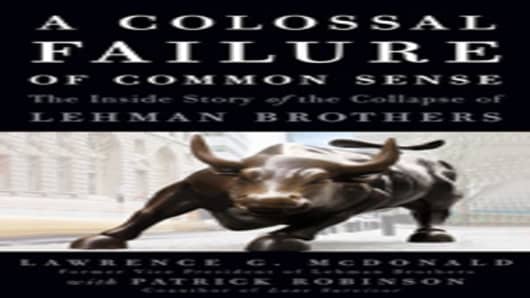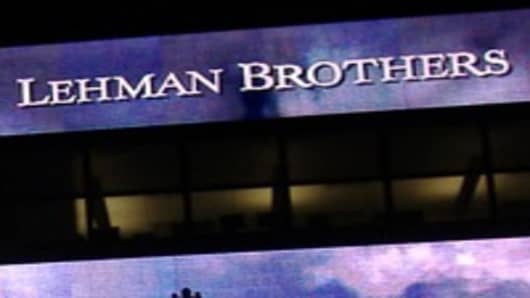A new book hitting the shelves today is getting a lot of attention. It’s the story of the rise and earth-shattering collapse of Lehman Brothers – a $600 Billion collapse - the largest bankruptcy filing in U.S. history.
A Colossal Failure of Common Sense: The Inside Story of the Collapse of Lehman Brothersby Lawrence G. McDonald with Patrick Robinson is the first book to tell the story behind the crash of Lehman a critical moment many say defined when our financial system went into free-fall.
McDonald, a former bond trader at Lehman says the firm’s leaders ignored all the warnings.
From the book's release he hopes to offer, "readers a fly-on-the-wall, insider look at the mad house that Lehman became. It will reveal never before told stories about the dark characters who ruled Lehman refusing to heed warnings that the company was headed for an iceberg; the world-class, mid-level people who valiantly fought to get Lehman off its disastrous course; the crash that didn't have to happen.”
Also in the book:
- An untold mutiny within Lehman upper management
- Three major warnings starting in May of 2005 that could have pulled Lehman back from the madness of the housing market
- Never before told efforts to save Lehman in the last days
McDonald the author of Colossal Failure of Common Sense: The Inside Story of the Collapse of Lehman Brothers is my guest blogger today and has written what follows below.
I wrote A Colossal Failure of Common Senseto expose the few that hurt so many.
Recently on CNBC, Joe Kernenreported that approximately 6.5 million jobs have been lost in this recession. My estimate is that 2 million of those lost jobs are at least the indirect result of the failure of Lehman Brothers.
The litany of ills is now all too familiar: families losing their homes; college tuition (even at state schools) becoming out of reach for many; recent graduates having a tough time finding work, (perhaps starting to think it has something to do with a personal defect, rather than the fallout from an economy that has spun out of control) business owners (neither able to make payroll nor pay suppliers) having to close their doors.
The pain out there is real and personal.
Many of these problems can be traced to the collapse of Lehman Brothers; and the cause of that collapse was centered on one of the most mysterious places on Wall Street - the 31st floor at Lehman Brothers, the floor where top executives presided.
If I have one key message I want the world to know it is simply this: The failure of Lehman Brothers did not have to happen.
Many will find this a surprising point-of-view. After all, wasn’t the Lehman bankruptcy the largest ever? Bigger in fact than Enron, WorldCom and Adelphia combined.
Even by Wall Street standards, Lehman was wildly, crazily overleveraged. At the top of the market in 2007, its net tangible equity was $17 billion versus its total investments around the globe of $750 billion. That’s a leverage of 44 times revenue!
Despite this astonishing degree of leverage the bottom line is that the collapse of Lehman Brothers should never have happened!
The plain and simple fact is that Lehman Brothers was not rotten at the core; she was rotten at the head. The head was ugly but the core of the firm was beautiful.
I want the world to know about all the wonderful profit engines that flourished inside Lehman Brothers, even at the very end. What was utterly shocking is that the best and brightest talent at Lehman was kept far away as possible from the 31st floor decision-making center.
Picture in your mind, if you will, a giant rocket loaded with powerful fuel and state of the art technology. At the very tip top of the rocket there is a small capsule where a few out-of-touch astronauts from another era preside. All that power, fuel and technology represent the brilliant talent inside Lehman Brothers while the few up top understood one thing above all others: how to hit the gas pedal.
There were about 25,000 people working at Lehman Brothers and, to me, its failure was the result of eight guys losing money while 24,992 people were making it.
My research for Colossal Failureincluded in-depth interviews with over 150 people who worked at all levels of Lehman Brothers.
I will never ever forget the shock on the faces of the many talented, high-level managing directors (people who were, for example risk committee members and department heads) at Lehman when they described their first conversations with chairman and CEO Richard Fuld and his management team. Many of Lehman’s best talent had never met Dick Fuld until June 2008. By then, Lehman was in such a financial hole that there was little they could do to help dig the firm out.
Lehman’s most talented people were horrified as they came to understand that Fuld and his cronies had a deep dark secret: They neither understood Lehman’s business, nor the depth of its distress – and they didn’t want their ignorance exposed.
A fair and logical question you might have: If Lehman’s top executives were not minding the store then what on earth were they doing?
Well how about keeping a sharp eye on the firm’s art collection? Not to mention Dick Fuld’s personal art collection worth more than $200 million at the top of the market. The 31st floor at Lehman Brothers looked more like a Sotheby’s art collection center than the nerve center of what had become a $750 billion hedge fund, which is exactly what Lehman had become by the summer of 2007. Art collecting, philanthropy, dress codes, and human resource campaigns such as diversity training ruled the daily agenda up on “Club 31.” It was all about image and playing the role ‘expected’ by people who were now new members of the billionaire club. Dick Fuld wasn’t a simple businessman. To protect his Kingdom, he didn’t just rule with an iron fist, he wore brass knuckles.
For years and years the best talent at Lehman was silenced. Anyone who spoke up, or God forbid went to Dick Fuld with any form of criticism about the aggressive growth business model he embraced, was quickly sent to the Lehman electric chair.
Lehman was full of super-bright people who understood the practical implications of the derivatives that Warren Buffett famously called “weapons of financial mass destruction.” Toiling away deep inside silos within Lehman Brothers, the game was: keep your head down and do your job, or lose both.
Transparency is the lifeblood of capitalism, but for many on “Main Street” Wall Street has become opaque and increasingly complex.
My second goal in writing A Colossal Failure of Common Sense, was to bring Main Streeters inside an investment bank and provide a front row seat to see how Wall Street really works. If Main Street has a better understanding of Wall Street, we will then have more transparency in our democratic capitalist society and hopefully prevent the mess we are in from repeating itself.
While many books have been written about modern finance, most are the work of academics and journalists. Few come from people with personal inside experience. A Colossal Failurein a very unique way provides the front row seat missing in other accounts.
My coauthor, Patrick Robinson, has published many successful books, including a number one New York Times bestseller, Lone Survivor.
Patrick had very little understanding of the basics of Wall Street such as the stock and bond markets much less the vastly more complex credit derivatives.
He was literally, the perfect complement to my inside knowledge, forcing me to make “extreme complexity” understandable to him. Instead of explaining things in Wall Street’s jargon-filled shorthand, Patrick made me spell it out clearly and simply. My hope then is that we have succeeded and that A Colossal Failureplays a useful role in making Wall Street and capitalism more transparent.
If investors don’t really understand how things really work deep in the engine room of an investment bank, then they are making sound investment decisions in a vacuum. Far too many people had their net worth destroyed.
Let’s not let it happen again, at least in my lifetime. One experience like we’ve had over the past two years is more than enough.
____________________________




No hay comentarios:
Publicar un comentario